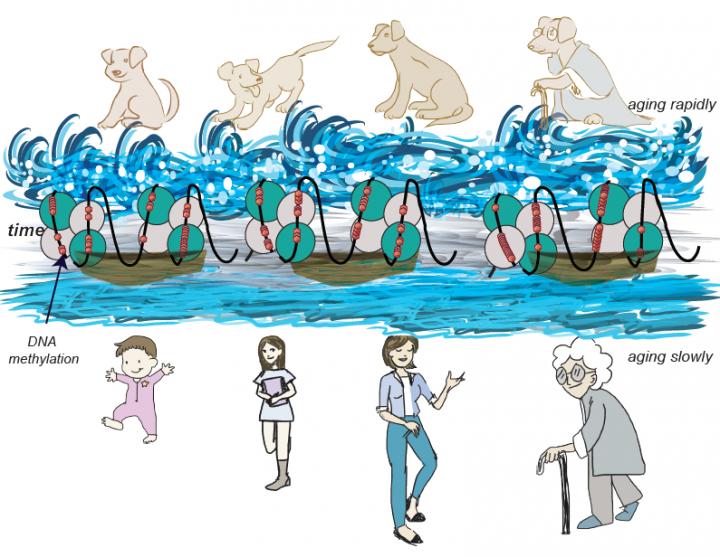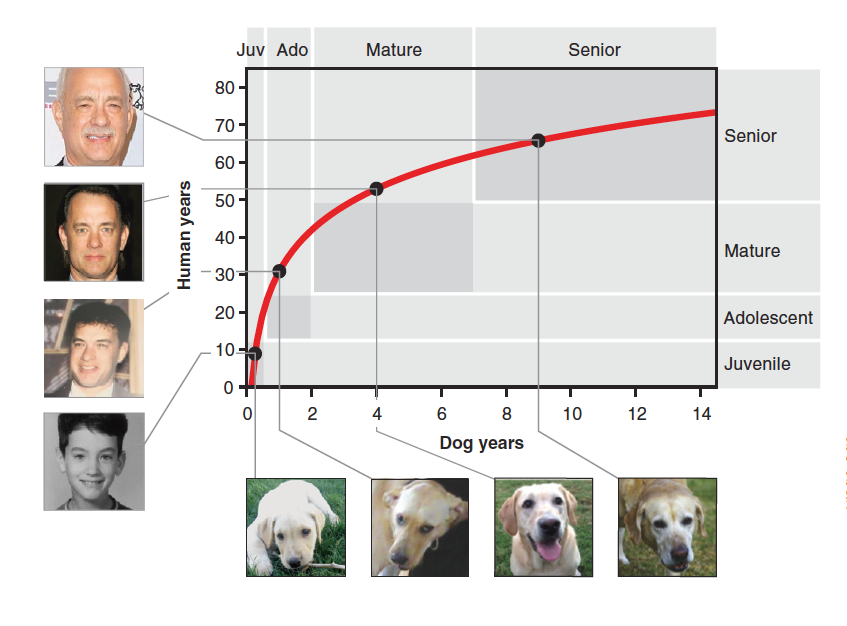As we mature through infancy, adolescence, adulthood, and our "senior" years, our bodies go through many changes. Our DNA blueprint remains constant, but the genes are activated and inactivated by methyl groups that attach to cytosine-guanine pairs – the DNA methylome. [1] DNA is the score, methylation, and the methylome, how the score is played.
Another term that encompasses the methylome is epigenetics – alterations in how our genes (the DNA) is expressed, the phenotype. There is increasing statistical evidence, that the methylome's behavior changes predictably over time, forming the basis for what scientists refer to as epigenetic clocks.
Using conventional measures of time, the tick-tock of the clock, calculating a dog's "age," was simply a matter of dividing a human's typical lifespan by the average lifespan of a dog – an extrapolation, where we use one pattern to predict another. To arrive at that new formulation, researchers made use of methylation's epigenetic clock, a clock that ages as our physiology ages, that separates the spry from the frail, in both dogs and humans. The underlying purpose of the research was not to better calculate a dog's life but to see to what extent epigenetic clocks function across species.
"Dogs share the same environment as their owners and receive almost the same standard of health care as humans, providing a unique opportunity for scientists to understand aging across species. Like humans, dogs follow similar developmental trajectories that lead them to grey and become more susceptible to age-related diseases over time."
Epigenetic effects are heavily influenced by many environmental factors from what we eat to where and how we live. So dogs who share much of our environment were a suitable species to consider, especially since their lifespan is shorter, so the progression of age is easier to establish. The scientists compared established methylome patterns in humans with methylome patterns developed using Labrador Retrievers across a wide age range. The patterns between the two were very similar at the ends of the spectrum, the very young and the very old. In between, the pattern of aging/methylation was much less consistent.
"What's surprising is exactly how old that one-year-old dog is--it's like a 30-year old human."
The rate of change between the methylome of humans and dogs was not the line described by human years multiplied by seven. It was more complicated, less linear. For those that wish to recalculate their dog's age the new formula is:
Age in human years = 16 ln(dog’s actual age) + 31
The dog and human share a progression of methylation patterns over different "chronological timepoints."

The epigenetic translation from dog age to human age and comes from the Ideker Lab, UC San Diego
The researchers went on to characterize the gene being activated and inactivated by the epigenetic clock. Four groups of developmental genes were predominant players with increasing methylation over time, and a fifth that showed decreasing methylation. [2] The accuracy of the timekeeping improved with the addition of the methylation pattern of mice, a third species – in keeping with our clock metaphor, "it took a licking, and kept on ticking."
While physiologic changes and milestones seem to "line up" across species, the timespan between those moments is unique to the species; there is no linear correlation to be found. And it seems that aging involves genes that previously were relegated solely to our early development; aging and development are not inseparable. The key result of the study is not showing the error in our dog-year conversion, but in demonstrating a new measurement tool, the methylome's epigenetic clock, that can help us to understand how we age and by extension how old we are physiologically. Perhaps 60 really is the new 40.
A Dog's Age in Human Years, as Portrayed by Tom Hanks
The authors throw this in for good measure.

Notes
[1] Affixing "ome" at the end of a word is increasingly used to holistically describe all of the components, static and dynamic, at a point in time and over time, of a complex system, like our intestinal microbiome. In this case, it refers to the complex system of methylation of our DNA.
[2] Those groups including two sets involved in anatomic development, one set involved in synapse assembly, and another in neuroepithelial cell differentiation. The fifth group was involved in nucleic acid metabolism and white cell differentiation – a total of about 363 genes.
Source: Cell Systems, Quantitative Translation of Dog-to-Human Aging by Conserved Remodeling of the DNA Methylome Cell Systems. DOI: 10.1016/j.cells.2020.06.006




